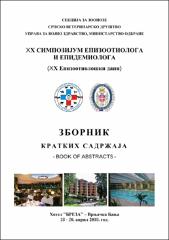| dc.contributor.author | Prodanov-Radulović, Jasna | |
| dc.contributor.author | Polaček, Vladimir | |
| dc.contributor.author | Molnar, Tibor | |
| dc.contributor.author | Živulj, Aleksandar | |
| dc.contributor.author | Martinov, Radoslav | |
| dc.contributor.author | Filipović, Siniša | |
| dc.contributor.author | Šubarević, Nemanja | |
| dc.contributor.author | Tomić, Aleksandar | |
| dc.contributor.author | Debeljak, Zoran | |
| dc.date.accessioned | 2019-11-03T15:42:11Z | |
| dc.date.available | 2019-11-03T15:42:11Z | |
| dc.date.issued | 2018 | |
| dc.identifier.isbn | 978-86-83115-33-4 | |
| dc.identifier.uri | https://repo.niv.ns.ac.rs/xmlui/handle/123456789/112 | |
| dc.description.abstract | In pig industry, biosecurity measures in preventing introduction and further disease transmission represent the cornerstones in sustainability of good organized, commercial production in the country. If the basic biosecurity rules are not respected at the farm, there is a risk of a certain disease enter into herd, which jeopardizes its sustainability both from the health, economic and welfare aspects, and from the aspect of the existing state low regulations. Biosecurity measures on commercial pig farms are of great importance for preserving the health status population as a whole, as they often carry out further distribution of pig breeding material to different type of family farms. The aim of the paper was determination of main biosecurity risks on pig farms, in accordance with existing specifics in different regions of the Republic of Serbia. Experts, epizootiologists of a number of specialist and one scientific veterinary institute participated in the data collection on existing biosecurity measures on pig farms. In the survey pig farms in the following districts were included: Južnobaèki, Severnobaèki, Sremski, Južnobanatski, Srednjebanatski, Severnobanatski, as well as Niški, Raški, Rasinski, Moravièki and Zlatiborski districts. Based on the achieved results of the biosecurity questionnaire conducted by epizootiologists, it can be concluded that the most significant biosecurity risks are related to different transport vehicles that enter the farm perimeter (transport of pigs to slaughterhouse, feed delivery), lack of adequate sanitary facilities for workers and visitors, lack of control of food intake by employees | en_US |
| dc.description.sponsorship | This work was supported by the Ministry of Education, Science and Technological Development of the Republic of Serbia, grant TR 31084 | en_US |
| dc.language.iso | other | en_US |
| dc.publisher | Srpsko veterinarsko društvo, Sekcija za zoonoze | en_US |
| dc.source | Zbornik kratkih sadržaja, XX Simpozijum epizootiologa i epidemiologa (XXEpizootiološki dani), Vrnjačka Banja, 18-20. april 201 | sr |
| dc.subject | biosigurnosne mere | en_US |
| dc.subject | rizici | en_US |
| dc.subject | farme svinja | en_US |
| dc.title | Utvrđivanje postojećih biosigurnosnih rizika na farmama svinja | en_US |
| dc.title.alternative | Determination of existing biosecurity risk on pig farms | en_US |
| dc.title.alternative | | en_US |
| dc.type | Book chapter | en_US |

